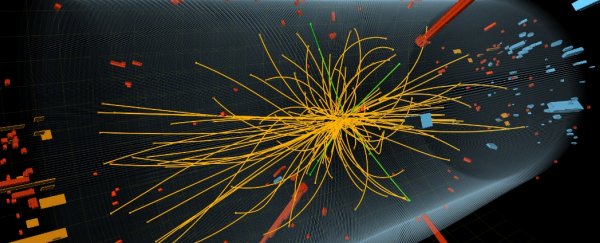Researchers at CERN have provided new insight into the behaviour of the tiny subatomic particles that make up protons and neutrons, called quarks, and they're consistent with the traditional Standard Model of particle physics.
That's great news for the Standard Model - a set of equations that explains the behaviour and interactions of particles in the Universe - but not so good for the supersymmetry hypothesis, which is a proposed extension that aims to fill in some of the gaps in the Standard Model. And those gaps aren't insignificant: the Standard Model can't explain dark matter and dark energy, or the force of gravity according to Einstein's theory of general relativity.
The new research looked into a specific type of quark called the bottom quark. There are six quark varieties - up, down, charm, strange, bottom, and top. The bottom quarks are heavier than the up and down quarks, and are able to shift their shape. Usually they become charm quarks when they do this, but they've occasionally been observed transforming into up quarks.
By smashing subatomic particles together using the Large Hadron Collider (LHC) in Switzerland, researchers have now calculated exactly how often that happens, and found that only bottom quarks with a left-handed spin decay into an up quark. And that's exactly what the Standard Model, but not the supersymmetry hypothesis, predicts.
"[The result is] entirely consistent with the Standard Model and removes the need for this [supersymmetry] hypothesis," lead researcher Guy Wilkinson told ABC Science. "It would of course have been very exciting if we could show that there was something wrong with the Standard Model - I cannot deny that would have been sensational."
One of the main purposes of the LHC is to try to extend physics beyond the Standard Model, which also can't explain the mass of the mysterious Higgs boson. Many physicists believe that supersymmetry, a hypothesis that suggests there's a heavier 'sibling' for every particle in the Universe, will be the next step.
But despite almost seven years of experimentation, the LHC has failed to find any evidence to support supersymmetry, and plenty of results consistent with the Standard Model. This discovery, which was made after trawling through years of observations on particle decay across the LHC, is just another nail in the proverbial coffin.
"It is one of the most frustrating confirmations we've ever had. We know our theory is incomplete, and this ultra-rare decay may give us clues as to what might replace it," one of the physicists involved, Tara Shears, from the University of Liverpool in the UK, said in a press release.
"What this discovery tells us is that there are no signs yet of our best alternative, a theory called supersymmetry (SUSY)," Shears added. "We haven't ruled out SUSY entirely, but we've definitely dismissed many of the most popular versions of it. We know that there must be new physics, but it's starting to look like this might be stranger than we'd imagined."
The good news is that this kind of measurement was previously assumed to be impossible with the LHC - researchers thought it would take an even more powerful particle collider. And the fact that the collider got an upgraded reboot in April this year suggests that we may soon get even more detailed observations.
And don't worry, supersymmetry isn't dead just yet. "It is very difficult to kill supersymmetry: it is a many-headed monster," Wilkinson told ABC Science. "If nothing is seen in the next couple of years, supersymmetry would be in a much harder situation. The number of true believers would drop."
The results have been published in Nature Physics. You can find out more about quarks below:
